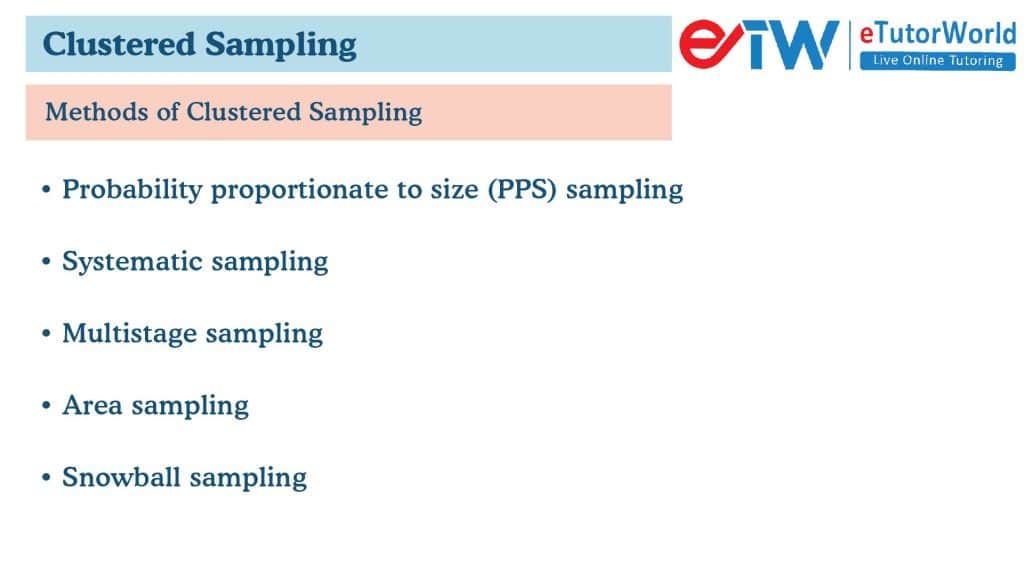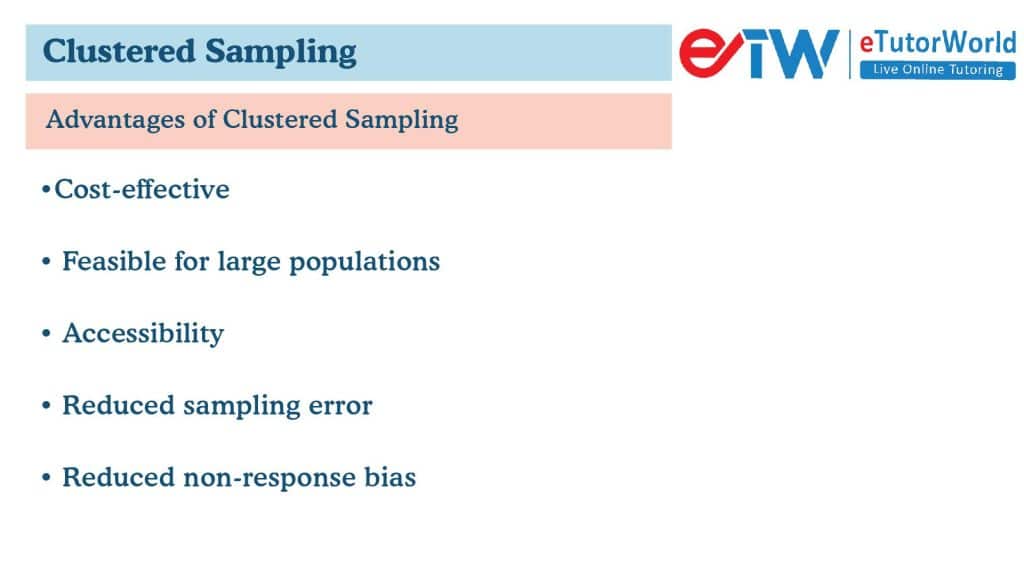Clustered Sampling
Grade 7 Math Worksheets
Clustered sampling is a sampling technique used in research studies where the population is divided into clusters or groups, and then a subset of these clusters is selected for the sample.
Table of Contents:
- Clustered Sampling
- Methods of Clustered Sampling
- Advantages of Clustered Sampling
- Disadvantages of Clustered Sampling
- FAQs
Personalized Online Tutoring
Clustered Sampling - Grade 7 Math Worksheet PDF
This is a free worksheet with practice problems and answers. You can also work on it online.
Sign up with your email ID to access this free worksheet.
"We really love eTutorWorld!"
"We really love etutorworld!. Anand S and Pooja are excellent math teachers and are quick to respond with requests to tutor on any math topic!" - Kieran Y (via TrustSpot.io)
"My daughter gets distracted easily"
"My daughter gets distracted very easily and Ms. Medini and other teachers were patient with her and redirected her back to the courses.
With the help of Etutorworld, my daughter has been now selected in the Gifted and Talented Program for the school district"
- Nivea Sharma (via TrustSpot.io)
Clustered Sampling
Clustered sampling is a sampling technique used in research studies where the population is divided into clusters or groups, and then a subset of these clusters is selected for the sample.
This technique is often used when it is difficult or impractical to obtain a complete list of individuals or items in the population, and when the clusters are more accessible or convenient to sample.
In clustered sampling, the clusters are selected randomly from the population, and then all individuals or items within the selected clusters are included in the sample.
This technique can help to reduce sampling costs and simplify the sampling process, as it is often easier to access and survey individuals within a cluster than across the entire population.
For example, in a study of healthcare access in rural communities, researchers might divide the population into clusters based on geographic location, and then randomly select a subset of these clusters for the sample.
Within each selected cluster, all individuals or households might be surveyed to collect data on healthcare access.
Clustered sampling can have some advantages, such as reducing sampling costs and simplifying the sampling process. However, it can also have some disadvantages, such as potentially increasing sampling error and reducing representativeness if the clusters are not truly representative of the population.
As with any sampling technique, researchers must carefully weigh the benefits and drawbacks of clustered sampling and select the method that is most appropriate for their research question and population of interest.

Methods of Clustered Sampling
There are various methods of clustered sampling that researchers can use to select clusters from the population. Some common methods include:

Probability proportionate to size (PPS) sampling: In this method, the probability of selecting a cluster is proportional to its size in the population. This technique is useful when the clusters vary widely in size.
Systematic sampling: In this method, the clusters are selected at fixed intervals from a list of clusters. This technique can be useful when the clusters are arranged in a systematic order.
Multistage sampling: In this method, clusters are selected in stages, with smaller clusters being selected first and larger clusters being selected in subsequent stages. This technique can be useful when the population is highly clustered and it is difficult to obtain a complete list of clusters.
Area sampling: In this method, the clusters are selected based on geographic regions or areas. This technique is useful when the population is spread across a large geographic area and it is difficult to access individuals or items in the population.
Snowball sampling: In this method, clusters are selected based on referrals from other individuals or clusters in the population. This technique can be useful when the population is difficult to access or when the individuals or items in the population are connected in some way.
The choice of method will depend on the characteristics of the population, the research question, and the available resources. It is important for researchers to carefully consider the advantages and disadvantages of each method and select the one that is most appropriate for their study.
Advantages of Clustered Sampling
Clustered sampling can have several advantages, including:

Cost-effective: Clustered sampling can be a more cost-effective sampling method, as it requires fewer resources and less time compared to other methods, such as simple random sampling.
Feasible for large populations: Clustered sampling is especially useful when the population is large and geographically dispersed, as it allows researchers to focus on smaller, more manageable areas or groups.
Accessibility: It can be easier to access individuals or items within a cluster than across the entire population, which can make data collection more efficient.
Reduced sampling error: By using clusters, researchers can reduce sampling error by capturing more of the variation within each cluster than they would with a simple random sample.
Reduced non-response bias: Clustered sampling can also help reduce non-response bias, as it is often easier to contact individuals within a cluster than across the entire population.
Overall, clustered sampling can be a useful and efficient method for sampling large and geographically dispersed populations, while still providing reliable and accurate results.
“There have been times when we booked them last minute, but the teachers have been extremely well-prepared and the help desk at etutorworld is very prompt.
Our kid is doing much better with a higher score.”
7th Grade Tutoring
eTutorWorld offers Personalized Online Tutoring for Math, Science, English, and Standardised Tests.
Our Tutoring Packs start at just under $22.49 per hour, and come with a moneyback guarantee.
Schedule a FREE Trial Session, and experience quality tutoring for yourself. (No credit card required.)
Disadvantages of Clustered Sampling
Clustered sampling can also have some disadvantages, including:
Reduced precision: Clustered sampling may result in lower precision compared to simple random sampling, as the variability within clusters may be higher than the variability between clusters.
Reduced representativeness: If the clusters are not truly representative of the population, then the sample may not be representative either. This can be a concern if the clusters are selected based on convenience or accessibility, rather than random selection.
Increased sampling bias: Clustered sampling may introduce sampling bias if the clusters are selected in a biased manner or if there is clustering of certain characteristics within the population.
Increased complexity: Clustered sampling can be more complex and time-consuming than other sampling methods, especially if multiple stages of clustering are required.
Potential for design effects: Clustered sampling may result in design effects, which can increase the standard errors of the estimates and reduce the statistical power of the analysis.
Overall, researchers must carefully consider the advantages and disadvantages of clustered sampling and select the method that is most appropriate for their research question and population of interest.
It is important to ensure that the selected clusters are representative of the population and to account for any potential biases or design effects in the analysis.
Do You Stack Up Against the Best?
If you have 30 minutes, try our free diagnostics test and assess your skills.
Clustered Sampling FAQS
What is the difference between cluster sampling and stratified sampling?
Cluster sampling involves dividing the population into clusters and selecting a random sample of clusters, while stratified sampling involves dividing the population into strata and selecting a random sample of individuals from each stratum. In cluster sampling, all individuals within the selected clusters are typically included in the sample, while in stratified sampling, only a subset of individuals from each stratum is included.
How do I determine the appropriate cluster size for my study?
The appropriate cluster size will depend on the characteristics of the population and the research question. Generally, larger cluster sizes can reduce the design effects and increase the precision of the estimates, but can also increase the potential for sampling bias. Smaller cluster sizes can reduce the potential for bias, but can also increase the design effects and reduce the precision of the estimates. Researchers should carefully consider these trade-offs and select a cluster size that balances these factors.
How do I select the clusters for my study?
The method for selecting clusters will depend on the characteristics of the population and the research question. Probability proportionate to size (PPS) sampling is a commonly used method for selecting clusters, as it allows for unequal probabilities of selection based on the size of the cluster. Other methods, such as systematic sampling or area sampling, may be more appropriate for specific populations or research questions.
How do I analyze data from a clustered sample?
Analysis of data from a clustered sample requires accounting for the design effects and potential clustering of the data. This can be done using specialized statistical software or by adjusting the standard errors of the estimates using appropriate methods, such as the Taylor series approximation or the jackknife method.
What are some common applications of clustered sampling?
Clustered sampling is commonly used in public health research, environmental research, social sciences, and market research. It is especially useful for sampling large and geographically dispersed populations, such as households, schools, or neighborhoods.

Gloria Mathew writes on math topics for K-12. A trained writer and communicator, she makes math accessible and understandable to students at all levels. Her ability to explain complex math concepts with easy to understand examples helps students master math. LinkedIn
Affordable Tutoring Now Starts at Just $22.49
eTutorWorld offers affordable one-on-one live tutoring over the web for Grades K-12. We are also a leading provider of Test Prep help for Standardized Tests (SCAT, CogAT, MAP, SSAT, SAT, ACT, ISEE, and AP).
What makes eTutorWorld stand apart are: flexibility in lesson scheduling, quality of hand-picked tutors, assignment of tutors based on academic counseling and diagnostic tests of each student, and our 100% money-back guarantee.
Whether you have never tried personalized online tutoring before or are looking for better tutors and flexibility at an affordable price point, schedule a FREE TRIAL Session with us today.
*There is no purchase obligation or credit card requirement
Grade 7 Science Worksheets
- Elements and Compounds
- Solar Energy
- Photosynthesis
- Electricity and Magnetism
- Law of conservation of energy
- Periodic table
- Properties of Matter
- Waves
- Energy Resources
- Weather and Climate
- Immune, Circulatory and Digestive Systems
- Organs in Multi-cellular Organism
- Sedimentary, Igneous, and Metamorphic Rocks
- Structure of the Earth
- Law of Conservation of Mass
- Physical and Chemical Changes
- Scientific Method
- Human Digestive System
- Environmental Science
- Renewable and Non-renewable energy Resources
- Characteristics of Living Organisms
- Life Science
- Earth and Space Science
- Solar Eclipse
- Heat Technology
- Newton’s Laws of Motions
- Physical Science
- Tools, Measurement and SI Units
- Earth Atmosphere
- Interactions of Living things
- The Earth Ecosystem
- Organelles in Plant and Animal cells
- Layers of the Earth
- Cycles in Nature
Grade 7 Math Worksheets
- Fractions
- Linear equations word problems
- Statistics
- Properties of Parallel Line
- Finding slope from an equation
- Identifying Quadrilaterals
- Percent Change
- Properties of addition and multiplication
- Pythagorean Theorem
- Solving two step inequalities
- Symmetry
- Fractions to Decimals (New)
- Whole Number Exponents with Integer Bases (New)
- Adding and Subtracting Fractions (New)
- Integer Addition and Subtraction (New)
- Dividing Mixed Numbers (New)
- Basics of Coordinate Geometry (New)
IN THE NEWS

Our mission is to provide high quality online tutoring services, using state of the art Internet technology, to school students worldwide.
Online test prep and practice
SCAT
SSAT
ISEE
PSAT
SAT
ACT
AP Exam
Science Tutoring
Physics Tutoring
Chemistry Tutoring
Biology Tutoring
Math Tutoring
Pre-Algebra Tutoring
Algebra Tutoring
Pre Calculus Tutoring
Calculus Tutoring
Geometry Tutoring
Trigonometry Tutoring
Statistics Tutoring
Quick links
Free Worksheets
Fact sheet
Sales Partner Opportunities
Parents
Passive Fundraising
Virtual Fundraising
Our Expert Tutors
Safe and Secure Tutoring
Interactive Online Tutoring
After School Tutoring
Elementary School Tutoring
Middle School Tutoring
High School Tutoring
Home Work Help
Math Tutors New York City
Press
©2022 eTutorWorld Terms of use Privacy Policy Site by Little Red Bird
©2022 eTutorWorld
Terms of use
Privacy Policy
Site by Little Red Bird









